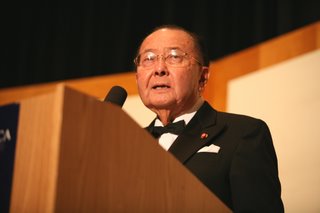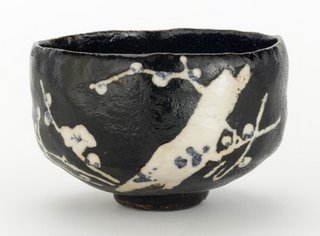The Smithsonian Associates, the educational learning arm of the Smithsonian Institution, will be hosting a series of
25 programs on Japan beginning March 31 and ending June 9. The program list is below. You can click on any program title to learn more and register.
Celebrate Japan WOW with the Music of RinSaturday, March 31, 2007 at 6 p.m.
Interested in making Japanese music accessible to the American ear, the members of Rin combine the exotic and subtle sounds of traditional Japanese instruments with a contrasting framework of contemporary Western popular music.
Kurokawa NohWednesday, April 4, 2007 at 6:30 p.m.Noh is the classical, older symbolic drama. The stories are based in history or classical literature, structured around song and dance, and presented on a very simple stage.
Pictures of the Floating WorldSunday, April 15, 2007 at 2 p.m.The creation of Ukiyo-e, a genre of Japanese paintings and woodblock prints first produced in the 1600s, is a tradition that has been embraced by such masters as Hiroshige, Hokusai, and Yoshitoshi.
Tokyo, Now and ThenMonday, April 16, 2007 at 6:30 p.m.Tokyo is a flashy hyper-modern city that signifies up-to-theminute chic. But at the same time, it’s a historic castle town with a complexly layered fabric of intimate old neighborhoods.
Religious Traditions of JapanSaturday, April 21, 2007 at 10 a.m.It is difficult to imagine what Japan would have been like without the religious traditions of Shinto and Buddhism, which have been a part of its cultural fabric since earliest times.
Manga to Anime: From Astro Boy to Spirited AwaySaturday, April 21, 2007 at 10 a.m.From the humble beginnings of a newspaper comic strip in 1946 to the highest-grossing film in Japanese history in 2001 (Spirited Away), manga (comics and print cartoons) and anime (animation) are now two of Japan’s biggest cultural emissaries.
Bonsai at Nat'l ArboretumSunday, April 22, 2007 at 10 a.m.The art of growing miniature trees, called penjing, originated in China and was adapted in Japan as bonsai. The National Bonsai and Penjing Museum at the U.S. National Arboretum has developed one of the largest collections in North America.
The Japanese Art of BonsaiSunday, April 22, 2007 at 1 p.m.The art of growing miniature trees, called penjing, originated in China and was adapted in Japan as bonsai. The National Bonsai and Penjing Museum at the U.S. National Arboretum has developed one of the largest collections in North America.
Sumi-e and Shodo: Traditional Japanese Ink Painting and CalligraphySunday, April 22, 2007 at 10 p.m.In this course combining the Japanese art forms of sumi-e and shodo, explore the basic principles of classical Oriental painting and brushwork.
Japanese KimonoTuesday, April 24, 2007 at 6:30 p.m.Kimono patterned with golden threads will surround you in the Gallery of the Mandarin Oriental Hotel at this talk and private viewing of the 2007 National Cherry Blossom Festival kimono exhibition.
Bunraku: The Amazing Puppets Of JapanFriday, April 27, 2007 at 10:15 a.m.In a very special show for Japan WOW! at The Smithsonian Associates, Japanese puppetry artists introduce this ancient puppet technique to young audiences.
Bunraku: The Amazing Puppets Of JapanFriday, April 27, 2007 at 11:30 a.m.In a very special show for Japan WOW! at The Smithsonian Associates, Japanese puppetry artists introduce this ancient puppet technique to young audiences.
BunrakuFriday, April 27, 2007 at 7:30 p.m.The term bunraku refers to the puppet tradition of Osaka developed before 1600. The Bunraku Bay Puppet Troupe presents four traditional pieces, using puppets one-half to full life-size.
Kodomo-No-Hi: Its' Children's Day!!!Friday, May 4, 2007 at 10:15 a.m.Learn about Japanese Children's Day with Shizumi Shigeto Manale.
Kodomo-No-Hi: It's Children's Day!!!Friday, May 4, 2007 at 11 a.m.Ages 6 to 10: Learn about Japanese Children's Day with Shizumi Shigeto Manale.
Kodomo-No-Hi: It's Children's DayFriday, May 4, 2007 at 11:45 a.m.
Ages 6 to 10: Learn about Japanese Children's Day with Shizumi Shigeto Manale.
Kodomo-No-Hi: It's Children's DayFriday, May 4, 2007 at 12:30 p.m.
Ages 6 to 10: Learn about Japanese Children's Day with Shizumi Shigeto Manale.
The Art of OrigamiSaturday, May 5, 2007 at 10 a.m.Come celebrate spring by folding origami flowers, with a butterfly, swan, and jumping frog thrown in for fun.
Sogetsu Ikebana: Modern Japanese Flower ArrangingMonday, May 7, 2007 at 6:30 p.m.The elegance and aesthetic harmony of ikebana—Japanese flower arranging— have inspired poets and artists since its creation more than 500 years ago.
Moku-Hanga: The Japanese Woodblock Print Monday, May 7, 2007 at 6:30 p.m.Students in this class learn the history of the medium and the traditional Japanese method for making both black-and-white and multicolor woodblock prints.
Rooted in History: Traditional Japanese VillagesTuesday, May 8, 2007 at 6:30 p.m.Japanese villages from tropical southern Okinawa to remote northern Hokkaido trace their history back—at least in legend— for more than a millennium.
Soft Power, Global CoolWednesday, May 9, 2007 at 6:30 p.m.Japan is one of the most influential of the world’s soft powers - indirectly influencing the world through cultural icons and ideas. With the spread of its goods and images, Japan has a new international face as the "king of cool" and is finding a new place in the world.
Beyond Sushi: Culinary Japan From Classical to ModernSaturday, May 12, 2007 at 9 a.m.Japanese cuisine has been wowing the rest of the world for centuries, while Japanese chefs at home have modified their traditional methods to incorporate new ingredients and new food-preparation techniques.
Japanese KimonoTuesday, May 15, 2007 at 6:30 p.m.Kimono patterned with golden threads will surround you in the Gallery of the Mandarin Oriental Hotel at this talk and private viewing of the 2007 National Cherry Blossom Festival kimono exhibition.
The History of Japanese Theater: KabukiWednesday, May 16, 2007 at 6:30 p.m.Nohgaku, bunraku, and kabuki are the best-known theater arts of Japan. Their origins are traceable to shrine rituals and early dengaku (field-dances and songs), which evolved into major theatrical forms.
Japanese FashionSaturday, May 19, 2007 at 7 a.m.Study leader Nobue Isono, a highly respected Japanese fashion expert, takes you on a full-day trip to New York City - the fashion capital of the world - to explore the characteristics and current trends in Japanese fashion.
Robots, Science, Technology: Japan Creates the FutureSaturday, May 19, 2007 at 10 a.m.Get a glimpse of Japan’s latest creations, hear from some of its leading innovators, and discover why Japan loves its robots in this intriguing program.
An Inspiring Evening with Michio KushiTuesday, May 22, 2007 at 7 p.m.In this special evening, teacher and author Michio Kushi, founder of the world-renowned Kushi Institute in Massachusetts, is interviewed about his life and career.
Japan and America—Partners Facing a Changing WorldThursday, June 7, 2007 at 6:30 p.m.Few nations have enjoyed such mutually beneficial relations as have Japan and the United States during the past 60 years. While the partnership between these two economic giants remains strong, both face important new challenges, as well as opportunities, in the days ahead.
Kyoto, Ancient Imperial CapitalSaturday, June 9, 2007 at 10 a.m.
Take an enchanting armchair stroll through one of Japan’s oldest and most beautiful cities, which served as the nation’s capital for more than a thousand years.


